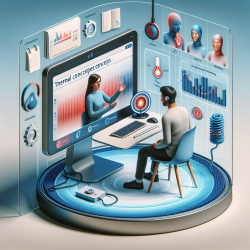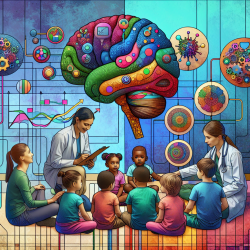Introduction
In the field of speech-language pathology, particularly within online therapy services like those provided by TinyEYE, the integration of scientific research into practice is crucial for optimizing therapeutic outcomes. A recent study titled "Thermal transport crossover from crystalline to partial-crystalline partial-liquid state" provides intriguing insights that, while rooted in material science, can inspire speech-language pathologists to enhance their practice through data-driven approaches.
Understanding the Research
The study explores the thermal transport mechanisms in phase-change materials (PCMs), specifically lithium sulfide (Li2S). These materials exhibit unique properties, transitioning from a crystalline state to a partial-crystalline partial-liquid state as temperature increases. This transition affects thermal conductivity, with significant contributions from phonons, convection, and phonon-convection interactions.
Key findings include:
- Below 800K, thermal conductivity follows a 1/T trend typical of crystalline solids.
- Between 800K and 1000K, the influence of liquid-like behavior begins to manifest, altering thermal transport properties.
- Above 1100K, the contributions from liquid and lattice-liquid interactions become significant, with diffusons contributing up to 46% of total thermal conductivity at 1300K.
Implications for Online Therapy
While the study focuses on material science, the underlying principles of phase transitions and dynamic interactions offer valuable parallels for speech-language pathologists. Here’s how practitioners can leverage these insights:
- Adaptability: Just as materials transition states, therapy sessions should adapt to the evolving needs of children. Practitioners can use data to identify when a shift in strategy is needed, ensuring that interventions remain effective.
- Dynamic Interactions: The interplay between different components in PCMs can inspire therapists to consider the dynamic interactions within a child's learning environment. Engaging multiple sensory modalities and adjusting based on feedback can enhance learning outcomes.
- Data-Driven Decisions: The study underscores the importance of quantitative analysis. Similarly, therapists should utilize data to assess progress and tailor interventions, ensuring that therapy is both effective and efficient.
Encouraging Further Research
The findings from the thermal transport study encourage speech-language pathologists to delve deeper into research that may seem unrelated at first glance. By exploring interdisciplinary studies, practitioners can uncover innovative strategies to enhance their therapeutic approaches.
For those interested in the detailed mechanisms of thermal transport and its broader implications, I encourage you to explore the original research paper: Thermal transport crossover from crystalline to partial-crystalline partial-liquid state.
Conclusion
By drawing connections between seemingly disparate fields, speech-language pathologists can enrich their practice and ultimately create better outcomes for children. Embracing a data-driven approach, inspired by research in fields like thermal transport, ensures that therapy remains innovative and effective.










